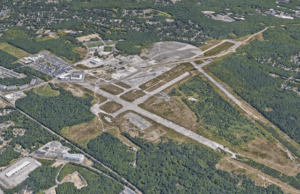Who is a member?
Our members are the local governments of Massachusetts and their elected and appointed leadership.

The town of Weymouth has received $32.4 million in state funding for infrastructure planning and upgrades to support the redevelopment of the former South Weymouth Naval Air Station. (Photo courtesy town of Weymouth)
State and local officials hope that a $32.4 million grant that Weymouth received this summer will help remove longstanding obstacles to the redevelopment of the former South Weymouth Naval Air Station. Plans would expand the town’s access to water services and eventually help ease the housing crunch on the South Shore.
The $32.4 million MassDevelopment grant will go toward water service, sewer, and road improvements needed for redeveloping the former military base’s roughly 1,400 acres in Weymouth, Abington and Rockland. Weymouth, which currently provides water and sewer to the property and encompasses most of the property, also received a $2.6 million MassWorks grant last year for design costs, bringing the total to $35 million for the work.
The funding will also support efforts to explore Weymouth’s potential for getting connected to the Massachusetts Water Resources Authority as the town’s water source.
Acting Mayor Michael Molisse, who took office in July and is running unopposed in next month’s election, said the funding represents an important step forward.
“I’ve served on the council for 25 years, so I’ve followed this through since 2000, when I was first elected to the council,” Molisse said. “And I’ve seen it up and down, up and down. I think this is the most positive spot I’ve seen it [in]. The base closed in 1997, so to see it at this point is very encouraging, and hopefully we can move it forward in my administration.”
The grant agreement was the last document signed by Robert Hedlund, Weymouth’s previous mayor who stepped down on July 15 after almost a decade in office. Securing the funding entailed coordination among the town, regional officials, the Healey-Driscoll administration, and legislators. In a statement about the grant, House Speaker Ron Mariano said the redevelopment will help revitalize the community, with statewide implications.
“As a lack of housing continues to drive folks out of Massachusetts,” Mariano said, “this project is a blueprint for how the Commonwealth can address the housing crisis head on, and bolster economic development at the same time.”
The plan calls for the development of 6,000 new housing units and about 2 million square feet of commercial buildings, including restaurants, retail and office space. Officials said the development would result in an estimated $22 million annually in local and state tax revenue. The plan also envisions the preservation of 885 acres of open space. Almost 1,300 housing units (not counted in the 6,000 estimate) have already been built on the property.
The military base was originally commissioned during World War II for blimps patrolling submarine activity in the Atlantic Ocean. After the war, it served numerous military functions.
Since the base closed, there have been numerous false starts, as development plans, and developers, came and went, due to financing, infrastructure needs, and the lack of water capacity. New developers are on board now, and officials said the state funding demonstrates public commitment to the redevelopment.
“It’s been probably the biggest challenge of where we’re at right now with this process, and of the last 10 years, if you will,” said Ted Langill, Molisse’s chief of staff. “Because, you know, people have those memories about the start-and-stop. So it’s on the trust level. It’s a challenge to convince people that this is different.”
The grant will help fund the design and permitting of new water and wastewater infrastructure, as well as roadway improvements. This will include design, permitting and construction documents for a new, roughly 7-mile water main from the existing MWRA system to the Weymouth municipal system; construction of water mains and design and construction of sewer mains; sewer main replacements; road widening projects; and design and construction of safety and traffic signal timing improvements and traffic calming measures.